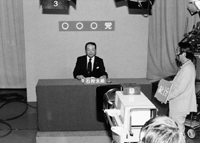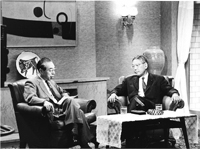Live from the Diet
After the war, TV exposed the Diet to public
scrutiny. A trial phase began on October 24, 1952, when NHK showed diet
members selecting the prime minister (Yoshida Shigeru). Thereafter, broadcasts
of the proceedings and general political debate were featured more prominently
on TV. NHK Radio launched Political Debate
in September 1947, and the program was televised from October 1957.

Test for broadcasts by political candidates |
Political Debate
made politics more transparent, as representatives of the government and
political parties discussed a wide variety of contemporary issues under
the watchful eye of the general public. Both politics and public opinion
became more visible.
Speaking with the Prime Minister
In 1961, the year following the great Kennedy-Nixon
campaign debate in the U.S., the Japanese prime minister appeared on
television for the first time. This came after Prime Minister Ikeda
Hayato's return from a meeting with U.S. President John F. Kennedy.
The first installment of Speaking with the
Prime Minister was aired on November 13, 1961.
In democratic societies, the will of the
people is paramount. Decisions are made according to how voters cast
their ballots. Discussion and consideration of multiple points of view
are keys to the formation of public opinion. TV provides an "open
forum" for this important process.
|
|

Speaking with the Prime Minister (Prime Minister
Ikeda Hayato on the right)
Defending democracy
In 1960, politics was in the spotlight as
never before in the postwar period. The governing and opposition parties
clashed over the revision of the U.S.-Japan Security Treaty, and social
unrest produced almost daily demonstrations in the area around the Diet.
Seven years after its birth, TV faced a tough test of its ability to
handle such issues.
In June, NHK launched a campaign "to
protect parliamentary democracy." The idea was formulated by then
NHK President Nomura Hideo, who emphasized that NHK's duty as a public
broadcaster was "to support political stability."
Between June 3-12, NHK aired a special 90-minute
daily program after the seven o'clock evening news. One program presented
the leaders of the three rival political parties. Others discussed the
true nature of parliamentary politics, and the relationship between
politics and the people. Another contained an interview with Prime Minister
Kishi Nobusuke. TV showed events in the Diet and rallies around the
country. The public became more interested in politics, and new ties
were forged between the people and TV.
Telecast of a murder
On October 12, 1960, Socialist Party Chairman Asanuma Inejiro was
stabbed to death by a rightist youth at a gathering being addressed
by the leaders of three political parties. The brutal scene was
repeatedly aired on TV, provoking considerable criticism. In the
midst of the protests against the U.S.-Japan Security Treaty, other
violent incidents and the kidnapping of a young child also occurred.
Dismayed by what seemed to be a growing disregard for human life
under the influence of TV, NHK President Nomura Hideo decided to
eliminate scenes of violence from NHK programs. As a result, even
foreign films in which pistols were shown as well as children's
historical dramas including fight scenes were halted for a period. |
Protecting children: outbreak of polio
|



